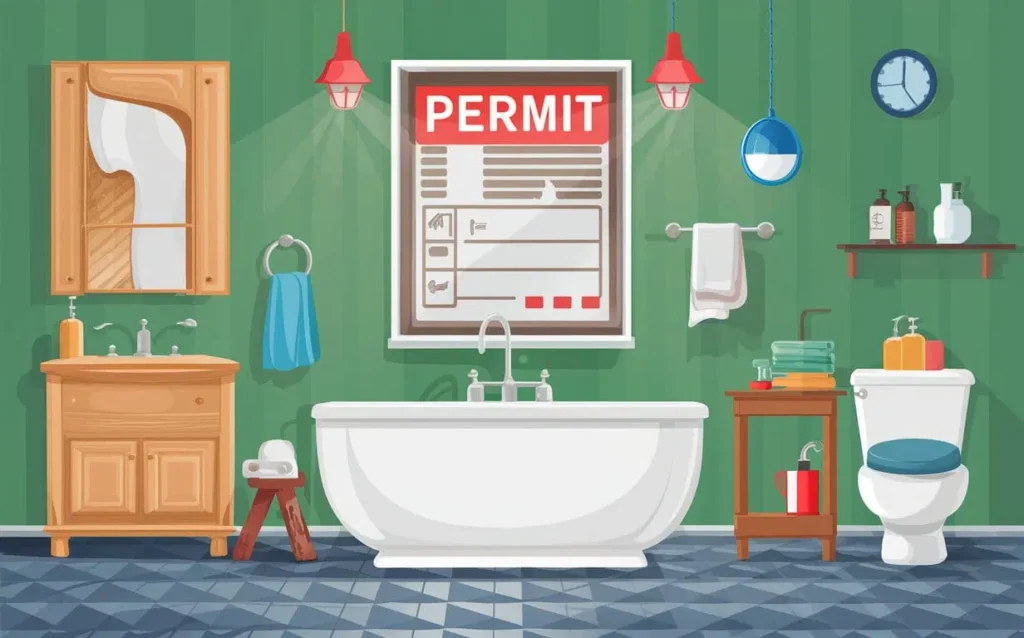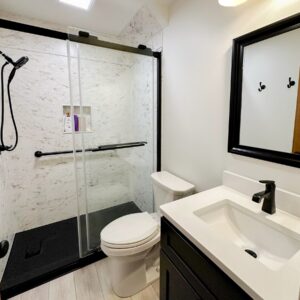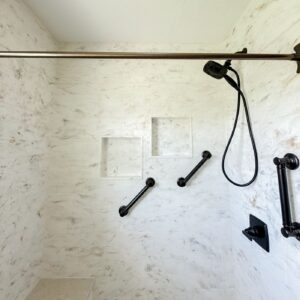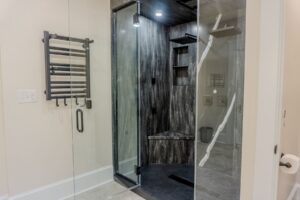You’re finally ready to transform that outdated bathroom into a spa-worthy retreat.
The moodboard is saved, the fixtures are picked, and the Pinterest rabbit hole was worth every minute.
It’s just a bathroom — how complicated can it be?
More than most homeowners realize.
What starts as a simple renovation can quickly get tangled in red tape — permits, inspections, and local building codes you didn’t even know applied.
And if you miss the mark?
You could face delays, surprise costs, or worse — being forced to undo completed work.
Even luxury-level remodels have been halted mid-construction over permit oversights.
So, do you need a permit for a bathroom remodel?
In many cases, yes. And knowing when is critical.
In this guide, we’ll walk you through:
- When bathroom remodels do require permits (and why)
- Which projects you can likely skip the red tape on
- How to avoid common myths and costly permit mistakes
- Pro tips to keep your project compliant, stress-free, and resale-ready
Let’s make sure your bathroom remodel runs as smoothly as it looks.
Why Permits Matter More Than You Think
It’s easy to assume a bathroom remodel is too small to require permits.
But whether you’re reimagining a powder room or gutting a primary suite, permits can have a major impact on your project’s cost, timeline, and long-term value.
Knowing when you need a permit for a bathroom remodel isn’t just about following rules. It’s about protecting your investment.
Permits Safeguard Your Home and Family
Permits aren’t red tape for the sake of it. They exist to ensure safety.
Whether it’s electrical wiring near a water source or plumbing that must be vented properly, permitted work is inspected for code compliance. That inspection acts as a second set of eyes to catch mistakes before they become expensive or dangerous.
Permits Help Preserve Your Home’s Value
Unpermitted work can lower your resale value. Or, stall a sale altogether. Home inspectors are trained to spot renovations that don’t line up with city records.
If your bathroom remodel included major changes without a permit, buyers may hesitate, and appraisers may adjust your home’s value downward to reflect the risk.
Permits Prevent Expensive Consequences Later
If the city finds out you’ve remodeled without the proper permits, they can issue stop-work orders, fines, or demand you tear out completed work to prove compliance.
In some areas, this can happen even years later — especially when a home hits the market. Permits are a simple way to avoid costly reversals.
Permits May Affect Insurance and Financing
Some homeowners don’t realize that unpermitted renovations can void parts of their homeowners insurance policy.
If a fire or flood occurs due to unpermitted electrical or plumbing work, your claim could be denied. Likewise, some lenders flag unpermitted additions during refinancing or home equity loan reviews.
When Do You Need a Permit for a Bathroom Remodel?
Not every bathroom upgrade triggers a permit.
But many do, especially when your remodel involves the systems that make the space function: plumbing, electrical, ventilation, and structural changes.
Understanding when you need a permit for a bathroom remodel can help you avoid delays, surprise costs, or worse — being forced to undo work after it’s complete.
Here’s a breakdown of the most common situations that require permits:
Structural Changes
Any time you remove, relocate, or alter walls — especially load-bearing ones — a permit is almost always required.
Even cosmetic changes like widening a doorway or moving the tub may involve structural elements that trigger permitting. These changes can affect your home’s integrity and require engineering review or city approval.
Plumbing Relocation
If your remodel includes moving a toilet, sink, tub, or shower to a new location, you’ll need a permit.
Rerouting water supply and drainage lines affects your home’s plumbing infrastructure and must comply with code to prevent leaks, contamination, or drainage issues.
Electrical Updates Near Water
Bathrooms are considered high-risk “wet zones,” so any electrical work like adding outlets, relocating switches, or installing lighting near the shower requires a permit.
In most cases, new wiring must meet current code, including ground fault circuit interrupter (GFCI) protection and proper spacing from water sources.
HVAC and Ventilation Adjustments
Installing or upgrading a bathroom exhaust fan?
Connecting the space to your home’s HVAC system?
These changes often require mechanical permits to ensure proper airflow, prevent mold growth, and comply with building codes. Poor ventilation is one of the most common causes of long-term moisture damage in bathrooms.
Window or Door Modifications
Changing the size or placement of windows or doors can involve both structural and energy code considerations.
Cutting new openings, enlarging existing ones, or installing tempered glass may require a permit — especially in exterior walls where weatherproofing and insulation come into play.
Waterproofing Systems
If your remodel involves installing a new waterproofing membrane, shower pan, or tile backer system, a permit may be required particularly if you’re building a custom walk-in shower or wet room.
While waterproofing might seem like a behind-the-scenes detail, improper installation can lead to hidden water damage, mold, and costly structural issues. Some municipalities require inspection at the waterproofing stage before walls or tile are closed up.
ADA or Accessibility Upgrades
Converting a bathroom for aging-in-place or accessibility?
Widening doorways, installing grab bars, adjusting sink heights, or reworking shower access can all trigger permit requirements. This comes into play if structural elements, plumbing fixtures, or electrical outlets are moved in the process.
Even when permits aren’t required, building to ADA standards ensures the space is safe, comfortable, and future-proofed.
When You May Not Need a Permit
Not every bathroom upgrade requires approval from the city. In fact, some of the most visible changes you’ll make — finishes, fixtures, paint — can often be done without any permits at all.
That said, even small upgrades can cross the line into regulated territory if you’re not careful.
Here are the types of work that typically don’t require permits, though you should always verify with your local building department.
Cosmetic Surface Upgrades
Replacing tile, repainting walls, installing wallpaper, or updating flooring can almost always be done without a permit. These changes are purely aesthetic and don’t alter any mechanical systems or structural elements.
Just keep in mind: If you discover water damage or rotted subfloor during demolition, that could trigger additional code requirements.
Replacing Similar Fixtures
Swapping out an old toilet for a new one? Replacing a vanity with the same size and footprint? Installing new faucets or showerheads?
As long as the new fixture connects to existing plumbing lines and no rerouting is required, a permit is generally not needed.
That said, always check whether local energy or water-efficiency codes apply to your product selections.
Hardware and Lighting Fixture Swaps
Changing cabinet pulls, towel bars, or mirrors is entirely cosmetic and never permitted. Even lighting swaps—replacing a fixture without modifying wiring—can often be done without a permit.
But as soon as you alter electrical circuits or move fixtures, you’ll cross into permit-required territory.
Decorative Additions
Adding open shelving, storage niches, art, or wall-mounted accessories rarely raises red flags.
As long as your additions don’t require cutting into walls, modifying outlets, or supporting significant weight, no permit is needed.
Gray Area Projects That Might Require a Permit
Some bathroom updates sit in a murky middle ground. They seem simple, but depending on your city or county, they may require permits.
These are the kinds of projects where homeowners often get tripped up:
- Converting a tub to a shower: If drain lines, waterproofing systems, or structural changes are involved, a permit is usually required. But in rare cases, a direct swap may fly under the radar.
- Installing a bidet or smart toilet: These may involve electrical outlets, water pressure changes, or backflow prevention — any of which can trigger code compliance.
- Upgrading ventilation: Replacing an exhaust fan could be considered routine maintenance—or a permit-required mechanical upgrade — depending on your jurisdiction.
- Swapping out recessed lighting: If new fixtures are heavier, require junction box changes, or increase electrical load, a permit may be needed.
The bottom line? When in doubt, ask.
A five-minute call to your building department — or working with a design-build firm that knows the local code — can save weeks of rework and stress later.
National vs. Local Permit Rules: Why It’s Not One-Size-Fits-All
One of the biggest misconceptions homeowners have is assuming permit rules are standardized.
In reality, what’s legal in one city may be noncompliant just a few zip codes away. Bathroom remodel permit requirements are governed locally.
And the variation can be dramatic.

City and County Building Departments Set the Rules
Each municipality has its own version of the building code, often adapted from the International Residential Code (IRC). But cities frequently make local amendments.
For example, one county may require permits for replacing a bathtub; the one next door might not. Even inspection processes and fees can differ significantly.
HOAs and Historic Districts Add Another Layer
If your home is part of a homeowners association or sits within a designated historic zone, permit requirements can get stricter.
You may need additional approvals — even for cosmetic changes — especially if your remodel affects exterior features like windows or walls. These layers can delay a project if not accounted for early.
Climate and Geography Influence Code
In colder regions, building codes often include requirements for insulation, vapor barriers, and frost protection—especially for plumbing.
In humid climates, ventilation standards may be more aggressive to prevent mold. Local environmental conditions shape what’s considered “safe” or “compliant.”
Luxury Homes Are Often More Scrutinized
High-end homes with custom plumbing, advanced electrical systems, or smart integrations may be more likely to trigger inspections — even if the project seems straightforward.
Building officials tend to look more closely at larger, more complex remodels, especially in areas with high property values or resale activity.
Permit vs No Permit: A Quick Comparison Table
Sometimes the line between what does and doesn’t require a permit isn’t obvious.
This table offers a quick snapshot of common bathroom remodeling tasks and whether they typically require permits.
| Project Type | Permit Needed? | Notes |
| Replace toilet in same location | No | Like-for-like swap with no plumbing reroute |
| Move toilet or sink to new location | Yes | Plumbing changes always require inspection |
| Replace shower tile or flooring | No | Surface-level updates are usually exempt |
| Convert tub to walk-in shower | Yes (often) | May involve plumbing, waterproofing, framing |
| Add recessed lighting over vanity | Yes | Electrical in wet zones is heavily regulated |
| Swap vanity light fixture | No (usually) | As long as wiring is untouched |
| Install new exhaust fan | Yes | Mechanical permits often required for HVAC work |
| Add grab bars or accessories | No | Minor hardware typically doesn’t need approval |
| Install smart bidet or toilet | Yes (possibly) | May involve electrical, plumbing, or both |
Note: Always check with your local building authority. Requirements vary by city and even by inspector.
Common Myths About Bathroom Remodel Permits
Permit requirements often catch homeowners off guard. Not because the rules are hidden, but because there’s so much misinformation out there.
From contractors brushing them off to neighbors saying “we didn’t need one,” it’s easy to fall into the trap of assumption.
But when it comes to knowing if you need a permit for a bathroom remodel, facts — not myths — protect your investment.
“My Contractor Said We Don’t Need One”
This is one of the most common — and risky—reasons homeowners skip permitting. While many contractors are knowledgeable, others cut corners to save time or avoid inspections.
Ultimately, you are responsible for code compliance as the homeowner. A reputable contractor will be transparent and help you navigate the process.
“I’m the Homeowner—It’s My House”
Yes, it’s your property.
But local governments still regulate how it’s modified, especially when safety or structural integrity is involved. Owning the home doesn’t exempt you from permits.
In fact, if you pull a permit yourself as a homeowner, you may be held to higher scrutiny if something goes wrong.
“I’ll Just Get a Permit After It’s Done”
Retrofitting a permit after the fact — called legalization — is possible in some jurisdictions, but it’s rarely simple.
Inspectors may require you to open up walls, provide engineering reports, or even redo work that isn’t visible. It’s more expensive, more time-consuming, and more stressful than doing it right the first time.
“It’s Just a Small Project. Who’s Going to Notice?”
Cities don’t rely on size—they look at scope. Moving plumbing or adding lighting can trigger code requirements regardless of how big or small the space is.
And if you plan to sell your home, buyers, inspectors, or appraisers will notice — even years later.
Pro Tips from a Luxury Remodel Specialist
Permits may not be the most glamorous part of your bathroom renovation — but they’re often the difference between a smooth, on-time remodel and one that drags, gets fined, or derails resale value.

At CalCo Design & Renovation, we’ve guided hundreds of homeowners through permitting with ease. Here’s what we recommend for a seamless experience:
Plan for Permits Early — Not After Demo Starts
Many homeowners wait until demolition to think about permits—by then, you’re already behind. Permits can take days or even weeks to secure depending on your city.
Work with your design team or contractor upfront to map out what needs approval and build it into your project timeline.
Don’t Assume Your Contractor Is Handling It
Some homeowners are surprised to learn their contractor didn’t pull permits—either out of habit or to save time. Make it crystal clear in writing who’s responsible.
In many areas, homeowners must sign off on permit applications anyway, so communication is key.
Use a Design-Build Firm That Handles Permits for You
The easiest way to sidestep confusion? Work with a full-service firm that handles everything—plans, permits, inspections, and compliance.
That way, nothing falls through the cracks, and you’re not juggling multiple vendors or approvals on your own.
Pad Your Timeline for Inspections
Even the most organized remodel can get delayed if the inspector’s schedule is tight.
Build in a few extra days between trades (plumbing, electrical, finish work) to allow for city inspections. It’s better to plan for buffer time than scramble when approvals are pending.
Do I Need a Permit to Renovate My Bathroom? FAQs
Even the most design-savvy homeowners have questions when it comes to permits.
And that’s understandable — regulations vary, contractors give conflicting advice, and online answers often oversimplify.
These frequently asked questions cut through the noise, offering clear, expert guidance on what really matters when navigating bathroom remodel permits.
Do I Need a Permit to Remodel a Small Bathroom?
Yes, in many cases. The size of the bathroom doesn’t matter as much as what you’re changing. Moving plumbing, updating electrical, or altering walls can all require permits—even in a compact space.
Do I Need a Building Permit to Renovate My Bathroom?
You may. A building permit is typically required when your renovation involves structural changes, wall modifications, or anything that affects plumbing, electrical, or ventilation systems. Always check with your local building department — or work with a contractor who handles this for you.
Who Pulls the Permit — You or the Contractor?
It depends. Some cities allow contractors to pull permits on your behalf, while others require the homeowner to be listed as the applicant. Either way, clarify this in writing before work begins. A full-service design-build firm will typically manage the entire process.
What Happens if I Remodel Without a Permit?
You risk fines, stop-work orders, difficulty selling your home, and potential issues with insurance claims. In some cases, the city may require you to remove completed work so it can be inspected and brought up to code.
Can I Get a Retroactive Permit After Remodeling?
Sometimes, but it’s not easy. Known as a “legalization,” this process often involves opening up finished walls, submitting new plans, and passing inspections. It’s more expensive and stressful than securing a permit upfront.
How Long Does It Take to Get a Bathroom Remodel Permit Approved?
It varies by location, but most permits take anywhere from a few days to several weeks. Timing depends on the scope of work, your city’s backlog, and whether your plans require engineering review or zoning checks.
Is a Permit Needed to Move Plumbing in a Bathroom?
Yes. Any time you move major fixtures like a toilet, shower, or sink — even by a few feet — a plumbing permit is typically required to ensure proper drainage, venting, and backflow protection.
Can a Homeowner Pull Their Own Permit?
Yes, in many jurisdictions. However, if you’re acting as your own general contractor, you assume full legal responsibility for the work and inspections. If you’re hiring professionals, it’s often better to let them handle it under their licensing.
Will Not Having a Permit Affect Resale or Home Insurance?
It can. Unpermitted work may lower your home’s appraised value, delay closings, or lead to denied insurance claims — especially if damage is traced back to non-compliant systems.
Permits Are Just Paperwork. Until They’re Not
Bathroom remodels are an investment in comfort, function, and long-term value.
But even the most beautiful design can hit a wall if permits are overlooked. Knowing when you need a permit for a bathroom remodel isn’t about bureaucracy — it’s about protecting what you’re building.
At CalCo Design & Renovation, we handle every detail, from layout to permitting to final finishes — so your renovation runs as smoothly as it looks.
Planning a remodel? Call us today to set up a free consultation.







